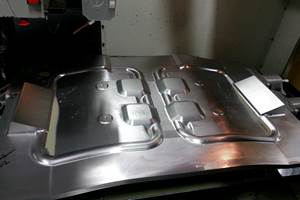Understanding Argument Assignment Number Two
With custom macro B there are two different forms of argument assignment for the G65 command to call a custom macro. By far, the more popular is argument assignment number one.
Share






With custom macro B there are two different forms of argument assignment for the G65 command to call a custom macro. By far, the more popular is argument assignment number one. Here are most of the local variable representations in with argument assignment number one:
A: #1, B: #2, C: #3, D: #7, E: #8, F: #9, H: #11, I: #4, J: #5, K: #6, M: #13, Q: #17, R: #18, S: #19, T: #20, U: #21, V: #22, W: #23, X: #24, Y: #25, Z: #26
While the local variable number selection may not make complete sense, these local variables are used in the custom macro to represent their corresponding letter addresses when argument assignment number one is used.
Now, here are the local variable representations when argument assignment number two is used:
A: #1, B: #2, C: #3, I: #4, J: #5, K: #6, I: #7, J: #8, K: #9, I: #10, J: #11, K: #12, I: #13, J: #14, K: #15, I: #16, J: #17, K: #18, I: #19, J: #20, K: #21, I: #22, J: #23, K: #23, I: #25, J: #26, K: #27, I: #28, J: #29, K: #30, I: #31, J: #32, K: #33
Notice that the letter addresses A, B, and C are followed by ten sets of I, J, and K. A, B, and C work just as they do in argument assignment number one, but I, J, and K are a little different. Think of the first set of I, J, and K as I(1), J(1), and K(1). Think of the second set as I(2), J(2), and K(2) – and so on through I(10), J(10), and K(10). Again, you’ll have up to ten sets of I, J, and K with which to work.
The first I in the G65 command will be represented by local variable #4; the first J by #5; the first K by #6. The second I in the G65 command will be represented by #7; the second J by #8, and the second K by #9. The tenth I in the G65 command (if there are ten) will be represented by #31, the tenth J by #32, and the tenth K by #33. Here’s an example call statement using argument assignment number two:
N010 G65 P1002 A1.75 B-0.6 C1.0 I12.0 J1.75 I35.0 J1.625 I175.0 J1.1 I25.0 J1.75 I113.0 J1.75
K is not being used in this example. Here is how the local variables will be assigned:
#1: 1.75, #2: -0.6, #3: 1.0, #4: 12.0 #5: 1.75, #7: 35.0, #8: 1.625, #10: 175.0, #11: 1.1, #13: 25.0, #14: 1.75, #16: 113.0, #17: 1.75
You may be wondering why argument assignment number two is so important. This method of argument assignment is helpful—and possibly the only way to handle the application—when you want to pass groups of information to the custom macro. Up to ten groups (ten sets of I, J, and K) containing three pieces of information each (again, I, J, and K values).
One potential application might be a tool life management system. Up to ten groups of tools could be specified in the G65 command, containing three pieces of information per group (possibly tool type, tool life in number of parts, and how many replacement tools are in the group).
The drawing below is for a circular cam—it’s actually the previously shown example.
As you can see, we’re using I and J (K is not needed) to specify the rises and falls around the cam. I specifies the angular length of the current rise or fall and K specifies its ending radius. Letter address A specifies the starting radius, B the depth to mill, and C the incremental angle for calculations (C1.0 will cause each movement around the cam to be 1.0 degree).
Here is the calling (main) program:
O2001 (Main program for cam)
N005 G54 (Set program zero)
N010 G65 P1002 A1.75 B-0.6 C1.0 I12.0 J1.75 I35.0 J1.625 I175.0 J1.1 I25.0 J1.75 I113.0 J1.75 (Mill entire cam)
N015 M30 (End of program)
Again, this kind of argument assignment makes it very easy to specify groups of data to your custom macro. With our cam example, a cam with up to ten rises and falls can be easily defined and machined.
There is not enough room to provide the entire cam custom macro program here. If you would like to see full program, visit http://www.cncci.com/resources/tips/arg2.htm.
Related Content
2 Secondary Coordinate Systems You Should Know
Coordinate systems tell a CNC machine where to position the cutting tool during the program’s execution for any purpose that requires the cutting tool to move.
Read MoreHow to Determine the Currently Active Work Offset Number
Determining the currently active work offset number is practical when the program zero point is changing between workpieces in a production run.
Read More4 Commonly Misapplied CNC Features
Misapplication of these important CNC features will result in wasted time, wasted or duplicated effort and/or wasted material.
Read More4 Tips for Staying Profitable in the Face of Change
After more than 40 years in business, this shop has learned how to adapt to stay profitable.
Read MoreRead Next
How I Made It: Dennis Rymanowski
Dennis Rymanowski has worked at NSH USA for 60 years, with his passion for manufacturing living alongside his passion for his family’s polka band.
Read MoreA New Frontier in Surface Finish Control
What if your machine tool could measure surface roughness as it cuts? This article explores how in-process metrology is advancing from concept to reality, enabling real-time feedback, immediate detection of anomalies and new levels of control over surface quality. Discover the technologies making this possible.
Read More.jpg;width=70;height=70;mode=crop)


















